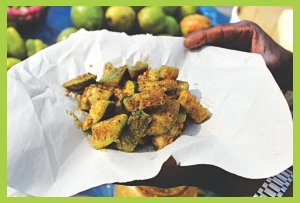|
Campus Edibles
Say Yes to Gray's Anatomy and No to Food
Sumaiya Ahsan Bushra
Photos: Kazi Tahsin Agaz Apurbo
"Cha…cha cha..!” demanded a bunch of impatient medical students while nervously tapping their fingers on the counter of the canteen. With the break of dawn till dusk, students of Bangladesh Medical College (BMC), rush in at all hours of the day to have tea at their canteen. It may seem strange and surprising to many but tea is the most sold item in the canteen of the medical college. However, apart from the popular element -- cha, most aspiring doctors (students) enjoy having nation's favourite snacks, samossa and shingara which is sold at a very affordable price of 4 - 6 takas each.

An assortment of all kinds of scrumptious snacks and meals.
Unlike most private and public universities, BMC's hospital canteen is unique in nature and size. Situated in an isolated corner of the university, sits the oldest eatery in all its glory. It is distinct from other canteens in the sense that it is not quite the gathering area for students. Most medical students are engrossed in piles of books all day long, so for them this small cafeteria fits in fine in their busy schedules.
BMC canteen sells mostly snacks and only a few meal items for students. The snacks include noodles, chicken fry, vegetable roll, hot dog, chicken pizza, chicken bun, moglai, dim chop (egg chop) and club sandwich. Amongst these varieties of items, the most favourite ones are the rolls and noodles which are sold at 12 takas and 20 takas each.
Taiqual Haque, a final year student at BMC says, “For a quick grab, a vegetable roll and a beef burger are my best options. Also, to keep me awake all the time, I have to drink a number of cups of coffee every day.” While, Anika Nawar, a freshman says, “My days are highly scheduled. I really don't have any time, between the hectic class hours, constant examinations and group study. The best thing to eat in a short time is the samossa or a roll.”
 |
Quick bites. |
In addition, when it comes to sweet items, they also sell plain cakes, chocolate pastries, pudding and the traditional finni, all of which are an excellent treat at the end of a long and mind-numbing lecture on nephrology, biochemistry or pharmacy. Also, in some cases, these act as great energy boosters for those weak-nerved first year freshers who faint every time when asked to inspect dead bodies in the dissection hall! In addition, for those who need something to munch on something all day, deshi chips and a wide assortment of biscuits are also available at the canteen.
The peak hour at which most students rush towards the cafeteria is between 1:00 and 2:00 o'clock. During this hour of the day, a number of students eat fried rice with an assortment of chicken curry or Chinese vegetable at an economical price of 75 takas. Sometimes, for students who are completing their internship and have to take night shifts, white rice, moshurer daal, bhaji (vegetable curry) and murgi (chicken curry) are available to them.
To quench one's thirst, not many options are available to students. But, highly caffeinated beverages like soft drinks and Nescafe coffee are sold at the canteen. This not only acts as stimulant for many students but also helps doctors and the worried members of the patient's family members to remain awake round the clock.
Like many universities, chotpoti and phuchka are sold at the canteen here as well. However, as one moves out of the canteen, a bunch of mamas are always there to serve the students loyally with a mixture of tasty munchies which often contains all kinds of contaminated elements of air and water. These munchies in some ways provide a platform for the medical students to treat themselves as experimental guinea pigs of highly dangerous diseases like diarrhoea, typhoid and jaundice.
 |
Contagiously mouth-watering bhortas. |
However, the picture of the consequences of eating these munchies may be unpleasant but watching the mama's concoct the recipe and possessing the ability to resist oneself is next to impossible. The delicious jhaalmuri or muri makha is often made with a thick mixture containing dices of tomatoes, cucumber, mustard oil, and mustard sauce, a pinch of black salt, drop of lemon juice and slices of green chilli. This assortment is added to the muri and chanachur which creates a tangy feeling leaving the mouth to crave for more. Very rarely, a small minority of students who love eating spicy muri makha, ask the mamas to add the fiercely hot bombai morich. This not only adds spice to the food but also adds a zesty flavour which teases the tongue. Apart from these, seasonal fruits are sold in carts in front of the main gate of the university. This includes peyara (guava) and aam (mango) makha. This too, is mixed with a similar sauce and is savoured by almost all the students of the university.
Life in medical colleges can be very challenging. With only a few minutes to spare every day, dedicating a huge chunk of time to enjoy eating and chit-chatting seems like an impossible thing to many. But still, in the midst of the thousand page edition of Gray's Anatomy, there still lies temporary joy in those mouth-watering moments that are caught between the small breaks.
|
Copyright (R) thedailystar.net 2011 |
